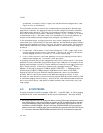
Vol. 3 4-11
PAGING
Because a PDE is identified using bits 31:22 of the linear address, it controls access
to a 4-Mbyte region of the linear-address space. Use of the PDE depends on CR.PSE
and the PDE’s PS flag (bit 7):
• If CR4.PSE = 1 and the PDE’s PS flag is 1, the PDE maps a 4-MByte page (see
Table 4-4). The final physical address is computed as follows:
— Bits 39:32 are bits 20:13 of the PDE.
— Bits 31:22 are bits 31:22 of the PDE.
1
— Bits 21:0 are from the original linear address.
• If CR4.PSE = 0 or the PDE’s PS flag is 0, a 4-KByte naturally aligned page table is
located at the physical address specified in bits 31:12 of the PDE (see Table 4-5).
A page table comprises 1024 32-bit entries (PTEs). A PTE is selected using the
physical address defined as follows:
— Bits 39:32 are all 0.
— Bits 31:12 are from the PDE.
— Bits 11:2 are bits 21:12 of the linear address.
— Bits 1:0 are 0.
• Because a PTE is identified using bits 31:12 of the linear address, every PTE
maps a 4-KByte page (see Table 4-6). The final physical address is computed as
follows:
— Bits 39:32 are all 0.
Figure 4-3. Linear-Address Translation to a 4-MByte Page using 32-Bit Paging
1. The upper bits in the final physical address do not all come from corresponding positions in the
PDE; the physical-address bits in the PDE are not all contiguous.
0
Directory
Offset
Page Directory
PDE with PS=1
CR3
4-MByte Page
Physical Address
31 2122
Linear Address
10
22
32
18


















